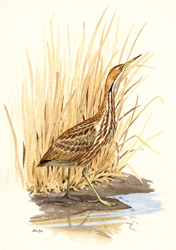Breeding Bird Atlases (BBA)
Find a Bird - BBA1
Breeding Bird Atlas 1 Species Accounts
American Bittern
Botaurus lentiginosus
State Status
Endangered
Egg Dates
May 5 to June 10
Number of Broods
one

With the increasing destruction, disappearance, and degradation of wetland habitat, the once common American Bittern has become a local, if not rare, summer resident throughout most of Massachusetts exclusive of Cape Cod, where it no longer breeds at all. Because of its preference for freshwater marshland and moist meadows for nesting, its breeding distribution is defined by areas where these specialized environments currently exist. During the Atlas period, most American Bitterns in the Commonwealth were found nesting in the few remaining extensive marshes and river meadows located in the eastern part of the state, or else in damp hayfields, bogs, and Beaver-created meadows in western Massachusetts.
Bitterns begin to arrive in Massachusetts in early April (earlier in some years) and may be found at breeding localities through late summer; however, they become markedly inconspicuous after their courtship calling ceases in late May. In the spring, the birds are best located by listening for the remarkable courtship “pumping” of the males. The noise produced is a hollow oonk-ka-choonk and, depending upon the listener’s age and life experience, sounds like the priming of an old pump or the sound of a distant pile driver, the precise effect being a function of one’s distance from the calling bird. In addition to producing these unusual sounds, male bitterns display by elevating whitish, ruff-like plumes from a point near the shoulder and extending them outward and backward, nearly encircling the hind neck. Much posturing is assumed during such display. Other vocalizations include various low, guttural, croaking notes, most of which are given by birds in flight.
By early May, most female bitterns have constructed their ground nests out of reeds, grasses, cattails, or other nearby plant material. Nests are generally concealed in marshes, sometimes on thick platforms of vegetation over the water and not infrequently in moist hayfields. The single clutch of four to five buffy-brown eggs is incubated by the female for 24 to 29 days, after which time the semialtricial young are tended by her at the nest for approximately 14 days and then for a short time after fledging. In the face of danger, both adult and young bitterns rely on their cryptic coloration for protection. With necks extended, beaks pointed skyward, and bodies greatly compressed, they resemble just another piece of marsh vegetation or debris. Fledged young have been recorded in the Quaboag River and East Brookfield River marshes from late June into July (Meservey, Keith).
At the end of summer, juvenile bitterns begin to wander from their natal marshes and, as the weather gradually turns colder, prepare to migrate southward. During October and November, the height of the migration, American Bitterns are encountered regularly in coastal salt marshes, most visibly during high tides. By late December, most bitterns have left Massachusetts. Occasional individuals attempt to winter along the coast, seldom successfully.
The American Bittern is listed as an endangered species in Massachusetts.
Map Legend and Data Summary
Atlas 1 data collected from 1975-1979


Note: rather uncommon and local in freshwater marshes
Wayne R. Petersen



